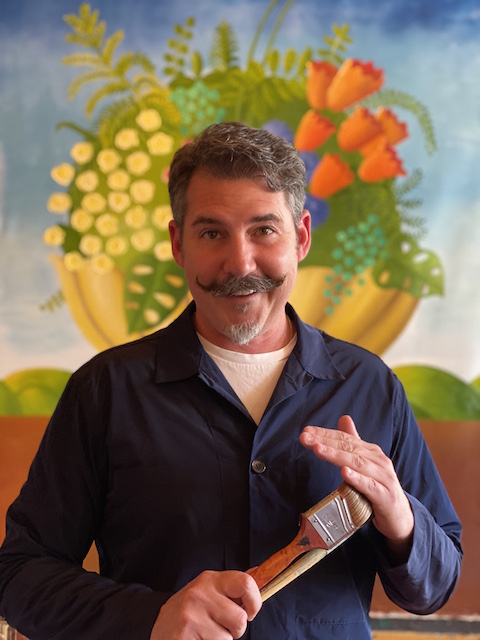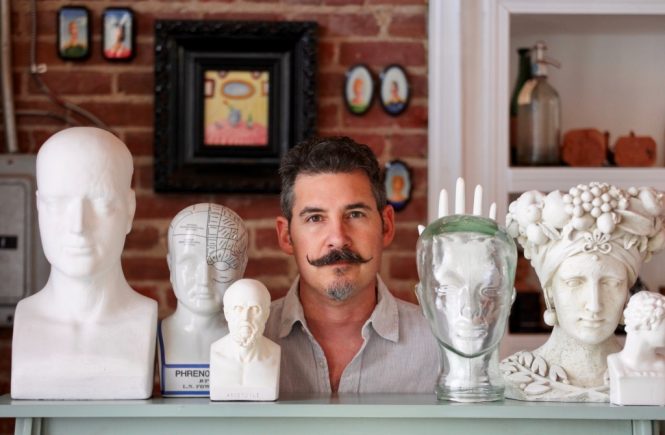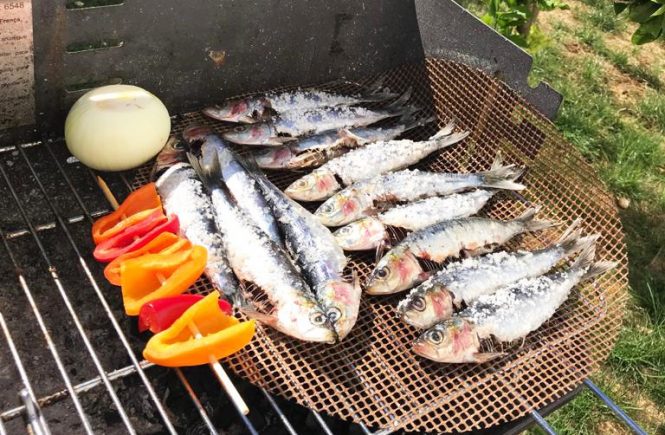Conheci Mocó através do meu irmão, que me mostrou uma tela do artista visual, natural de Currais Novos, residente nos Estados Unidos. Adorei o trabalho e dei um jeito de fazer uma surpresa e presenteá-lo no aniversário de seus cinquenta anos.
Uma rápida busca na Internet e consegui seu e-mail. Me apresentei como sua conterrânea e qual não foi minha surpresa, quando ele me respondeu dizendo ser amigo do meu irmão caçula (estudaram juntos), Karla, sua esposa, é amiga do meu irmão mais velho e Rasmussen, Mussinho e Mocó são a mesma pessoa.
A partir daí, trocamos e-mails e falamos do bem-querer comum que devotamos ao Seridó. Ofereci-lhe meus dois livros sobre a região: No Rastro das Águas e Sertão, Seridó, Sentidos. Por causa deles, hoje tenho em casa um quadro que sintetiza toda a minha memória de infância, assinado por Mocó (o ladrilho hidráulico do piso da casa da fazenda, a fotografia do ancestral importante, o queijo ferrado, a janela do sótão avistando o Bico da Arara, a bacia de ágata para lavar as mãos). Em bate-papos sobre arte, falamos de projetos futuros.
Quero compartilhar com os leitores as ideias desse artista talentoso que retrata em suas telas as raízes tão bem fincadas no Seridó, estendidas até a Califórnia. Vamos à entrevista com Rasmussen Sá Ximenes, o artista visual Mocó.

Elza Bezerra: Mocó, você começou sua carreira de artista meio na surdina. Graduado em geologia, trabalhou em postos burocráticos em Brasília, mas terminou indo para Califórnia estudar gastronomia. Em que momento a arte lhe encontrou?
Mocó: A arte sempre esteve presente em todas as fases da minha vida, na verdade o meu prazer é por causar surpresa, provocar espanto e a arte visual que produzo foi a maneira que mais chamou a atenção das pessoas! Entendi que eu consegui me comunicar melhor com essa linguagem! Mas o “clic” inicial que me fez acreditar que poderia ser um pintor notável, foi ao visitar o MOMA de San Francisco, quando tive oportunidade de ver as obras dos grandes mestres a centímetros de distância, de súbito um choque de sensibilidade, onde passei a entender o poder de uma obra de arte! Imediatamente quis fazer parte daquele mundo!
Elza Bezerra: David Hockney, o britânico que se tornou o artista vivo mais valioso da atualidade, encontrou na Califórnia a luz que lhe faltava no Reino Unido. Você tinha a luz em abundância do Seridó, mas foi se encontrar como artista nos Estados Unidos. Conte um pouco sobre o seu trabalho e o lugar que escolheu para viver e produzir.
Mocó: Assim como Hockney, também me senti estimulado em produzir na Califórnia, acredito que pelo mesmo motivo que a luz dourada provoca nas sombras e contrastes e gera um sentimento de nostalgia! Consigo também enxergar similaridade entre as cores carregadas nos trabalhos de Hockney e nos meus! Atualmente tento classificar particularidades entre as luzes que influenciam meu estilo de pintura e cheguei a conclusão que a luz do Seridó é tão intensa que as inspirações são captadas em “flashes”, são pequenas surpresas e cenas que ficam gravadas na memória, enquanto a luz da Califórnia é mais facilmente observável e retratável “in loco”! Em um primeiro momento escolhi a Califórnia acidentalmente, depois tentei produzir em outros Estados Americanos, entre eles a Flórida, em Miami Beach e que aí passei a produzir em outro estilo. Hoje produzo na Califórnia porque passei a entender que realmente aqui produzo com uma qualidade e intensidade melhor!

Elza Bezerra: As pessoas de sucesso têm o privilégio de trabalhar no que gosta. Hockney, que está com mais de oitenta anos, continua a produzir e diz se sentir com trinta anos quando está no estúdio. Então ele vai lá todos os dias para se sentir jovem. Você fala do seu trabalho com um brilho no olhar. Como manter essa energia e criatividade?
Mocó: Eu admiro o artista que se dedica e quer se reafirmar como tal a cada nova estação do ano, aliás, essa é uma condição inevitável de quem realmente se dedica a criar! Já sofri com momentos de “Blanck”, sem inspiração para pintar, as vezes até bate um desespero, pois há vontade, mas não há um motivo! Inclusive me reinventei e desenvolvi estratégias para episódios sem inspirações. Então, eu simplesmente faço uma faxina no meu Estúdio ou produzo outro tipo de expressão artística, inclusive a taxidermia e atualmente escrevo um roteiro para a produção de um filme documentário!

Elza Bezerra: Picasso tem uma frase em que diz: “um quadro só vive para quem o olha”. Seus quadros chamam a atenção pelas cores, texturas e riqueza de detalhes. O que não pode faltar na sua obra e como lida com a mudança temática, importante para renovar o olhar.
Mocó: O elemento que mais me chama atenção nas pinturas dos grandes mestres é a plasticidade exarcebada, a textura, a generosidade das tintas, a marca do pincel e a ausência das fibras entrançadas das telas, isso para mim é qualidade plástica, física, e procuro também fazer parte dessa qualidade! Uso sempre motivos estéticos para me inspirar, uma mesa bem posta, flores frescas em um vaso, um bolo ao sair do forno… são coisas simples, mas que ali consigo enxergar um valor sentimental, um apelo às boas lembranças, momentos confortantes e que possam ser transcendentes e emanar a energia que realmente senti durante a produção da obra!

Elza Bezerra: Você construiu um personagem meio vintage. Suas pinturas também resgatam costumes de outrora. Em plena era digital, ainda há espaço para cultura vintage?
Mocó: A questão de viver um personagem “vintage” e produzir como tal explica muito a condição de viver fora das minhas origens, a saudade, a nostalgia, tudo isso contribui muito na minha forma de expressão! A exemplo da minha mais recente coleção inspirada em flores. Trata-se de uma grande metáfora, na verdade eu tento abrir uma janela para o passado e tento não somente reproduzir os objetos, mas a essência do momento, é uma tentativa de provocar uma sensação de conforto ao espectador e isso faz jus a sua citação à frase de Picasso! Karla e eu temos total noção que estamos seguindo pela contramão do que hoje a Califórnia aposta! Vivemos a alguns minutos do Vale do Silício, onde estão sediadas as maiores companhias de tecnologia do mundo e achamos que a nossa briga é justa, pois o nosso sonho é tão grande quanto o deles!
Elza Bezerra: Como artista visual, onde se encaixa a fotografia e os vídeos em seu trabalho?
Mocó: Quanto à fotografia, não posso afirmar que é um complemento do meu trabalho, já que não fotografo artisticamente, uso-a somente como recurso para aprimoramento e comparação! Em relação aos vídeos, eu sempre tento reforçar uma leitura particular sobre o momento e o meu conjunto de inspirações para a obra protagonizada!
Elza Bezerra: Você e Karla transformaram um antigo casarão em seu estúdio de trabalho e lugar para receber. Explique para os leitores a Motocopia?
Mocó: MOCOTOPIA é um espaço utópico, onde através da arquitetura e objetos de época (1800) nós conseguimos agregar nossas sensações nostálgicas, tudo se transformou numa grande ferramenta de inspiração e que nos provoca a produzir arte de maneira honesta ao nosso discurso! A sensação de conhecer a MOCOTOPIA (Mocó + Utopia), é a mesma de estar participando da criação de uma obra de arte, de fazer parte dela, de caminhar pela pintura, de tocar nos objetos de interagir com personagens!

Elza Bezerra: O artista está sempre pensando no que ainda não fez. Quais seus projetos para o futuro?
Mocó: Eu estou obcecado em produzir um filme documentário sobre a realidade que encontrei na minha última visita ao Sertão do Rio Grande do Norte, não tenho dúvidas de que o mundo deveria conhecê-lo. Eu não consigo enxergar uma tragédia como muitos enxergam, eu vejo a beleza de um povo, a inocência, a calosidade e o desapego! Eu acredito que o nosso povo tem muito o que ensinar!
INTERVIEW WITH MOCÓ
I met Mocó through my brother, who showed me a canvas by the native artist from Currais Novos, living in California. I loved the artwork and I managed to surprise my older brother and present him on his fiftieth birthday.
A quick search on the Internet and I got his email. I introduced myself as his ‘countryman’ and what was my surprise, when he replied saying he was a friend of my younger brother (they studied together), Karla, his wife, is a friend of my older brother and Rasmussen, Mussinho and Mocó are the same person .
From there, we exchanged e-mails and talked about the common well-being that we devote to Seridó. I offered him my two books about our County: “No Rastro das Águas” and “Sertão, Seridó, Sentidos”. Because of it, today I have at home a painting that summarizes all my childhood memory (the hydraulic tile on the farmhouse floor, the photograph of the important ancestor, the primed cheese, the attic window overlooking Bico da Arara Hill), signed by Mocó. In artsy chats, we talk about future projects.
I want to share with the readers the ideas of this talented artist who portrays in his canvases the roots so well planted in Seridó, extended to California. Let’s go to the interview with Rasmussen Ximenes, Mocó.
Elza Bezerra: Mocó, you started your career as an artist quietly. Graduated in geology, you also worked in bureaucratic posts in Brasília, but went to California to study gastronomy. When did art find you?
Mocó: Art has always been present at all stages of my life, in fact my pleasure is causing surprise and astonishment. The visual art I produce was the way that most caught people’s attention! I understood that I was able to communicate better with this language!
But the initial “click” that made me believe that I could be a notable painter was when I visited the MOMA in San Francisco, when I had the opportunity to see the works of the great masters from inches away, causing a sudden shock of sensitivity, where I came to understand the power of art!
Elza Bezerra: David Hockney, the Britain who has become the most valuable living artist today, found in California the light he lacked in the United Kingdom. You had plenty of light from Seridó, but you found yourself as an artist in the United States. Tell us a little about your work and the place you chose to live and produce.
Mocó: Like Hockney, I also felt stimulated to produce in California, for the same reason that golden light causes shadows and contrasts and generates a feeling of nostalgia! I can also see similarity between the colors carried in Hockney’s works and mine!
Currently I try to classify particularities among the lights that influence my painting style and I came to the conclusion that the Seridó light is so intense that the inspirations are captured in “flashes”, are small surprises and scenes that are recorded in the memory, while the light of California is more easily observable and retractable “in loco”!
At first, I chose California accidentally, then I tried to produce in other American states, among them Florida, in Miami Beach and there I started to produce in another style. Today I produce in California because I came to understand that I really produce here with better quality and intensity!
Elza Bezerra: As successful people, they have the privilege of working on what they like. Hockney, who is over eighty, continues to produce and says he feels in his thirties when he’s in the studio. So he goes there every day to feel young. You speak of your work with a gleam in your eyes. How to maintain that energy and creativity?
Mocó: I admire the artist who is dedicated and wants to reaffirm himself as such with each new season of the year, in fact, this is an inevitable condition of those who are really dedicated to creating! I have already suffered with ‘blank’ moments, without inspiration to paint, sometimes this causes despair, because there is a will, but there is no reason! I even reinvented myself and developed strategies for uninspired moments. So, I simply clean up my Studio or produce another type of artistic expression, including taxidermy — as an example I am currently writing a script for a documentary film!
Elza Bezerra: Picasso has a sentence in which he proclaims: “a painting lives only for those who look at it”. His paintings are notable for their colors, textures and rich details. What cannot be missing in your work and how do you deal with the thematic change, important to renew your view?
Mocó: The elements that catch my attention in the paintings of the great masters are the exaggerated plasticity, the texture, the generosity of the paints, the brush strokes and the absence of the braided fibers of the canvases. For me it is plastic, physical quality, and I also look for part of that quality! I always use aesthetic reasons to inspire me, a well-set table, fresh flowers in a vase, a cake when leaving the oven… these are simple things, but there I can see a sentimental value, an appeal to good memories, comforting moments that can be transcendent and emanate the energy that I really felt during the production of the work!
Elza Bezerra: You built a somewhat vintage character. His paintings also recall old customs. In the digital age, is there still room for vintage culture?
Mocó: The question of experiencing a “vintage” character and producing as such explains a lot the condition of living outside my origins, longing, nostalgia, all of which contributes to my expression! Like my most recent collection inspired by flowers, this is a great metaphor, in fact I try to open a window to the past and not only reproduce the objects, but the essence of the moment, it is an attempt to provoke a feeling of comfort to the viewer, as the quote you have used from Picasso! Karla and I are fully aware that we are going against the grain of what California is betting on! We live a few minutes from Silicon Valley, where the biggest technology companies in the world are based and we think our fight is fair, because our dream is as big as theirs!
Elza Bezerra: As a visual artist, where does photography and videos fit in your work?
Mocó: As for photography, I cannot say that it is a complement to my work, since I do not photograph artistically, I use it only as a resource for improvement and comparison! Regarding the videos, I always try to reinforce a particular reading about the moment and my set of inspirations for the protagonist work!
Elza Bezerra: You and Karla transformed an old house into your work studio and place to receive. Explain Motocopia to readers?
Mocó: MOCOTOPIA is a utopian space, where through architecture and period objects (1800) we manage to add our nostalgic sensations, everything has become a great tool of inspiration and that provokes us to produce art in an honest way to our speech! The feeling of knowing MOCOTOPIA (Mocó + Utopia), is the same as participating in the creation of a work of art, being part of it, walking through painting, touching objects to interact with characters!
Elza Bezerra: The artist is always thinking about what he hasn’t done yet. What are your projects for the future?
Mocó: I am obsessed with producing a documentary film about the reality I found on my last visit to the region of Sertão in Rio Grande do Norte, I have no doubt that the world needs to learn about it. I cannot see a tragedy as many do, I see the beauty of a people, the innocence, the callosity and the detachment! I believe that our people have a lot to teach!
Acesse também: Memórias Roubadas, o Ateliê de Aécio e Visitando a Oficina Brennand.





2 comments
Elzinha ! Eu sou muito fã do trabalho de mocó, acompanho ele nas redes sociais. Foi muito bacana à sua entrevista com ele .👏👏👏👏
Oi Ana Teresa, é muito bom bater um papo sobre arte com um artista que traz nossas raízes, mescladas ao mundo contemporâneo. Siga firme no blog, outros posts e entrevistas virão. Abraço